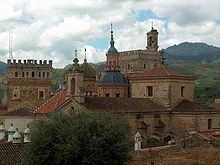Extremadura
![]()
This article is about Extremadura in Spain, not to be confused with the region of Estremadura in Portugal.
![]()
This article or subsequent section is not sufficiently supported by evidence (e.g., anecdotal evidence). Information without sufficient evidence may be removed in the near future. Please help Wikipedia by researching the information and adding good supporting evidence.
Extremadura is one of the 17 autonomous communities of Spain and is located in the southwest of the country, bordering Portugal. Extremadura includes the provinces of Cáceres and Badajoz.
The name Extremadura comes from "extremos del Duero", which means "beyond the river Duero".
Extremadura covers 8.3% of Spain's land mass, but has only 2.6% of Spain's population, with a population density of 25 inhabitants per km².
The population, known as Extremeña or Extremeño, is spread over 383 municipalities. The only city with more than 100,000 inhabitants is Badajoz (150,000 inhabitants). The next largest cities are Cáceres (96,000 inhabitants) and the capital of the autonomous community, Mérida (59,000 inhabitants). About 57% of the population lives in municipalities with less than 10,000 inhabitants.
The regional economy has improved in recent years, catching up faster than other regions in Spain between 1985 and 1999. Extremadura has benefited from EU cohesion funds, supporting projects in the fields of education, social protection and the economy.

Monasterio de Guadalupe

Old town of Cáceres
Geography
Extremadura has an area of 41,634 km², representing 8.2% of the Spanish land mass. It is larger than Switzerland, Belgium or the Netherlands and the fifth largest autonomous community in Spain. Extremadura is made up of the 19,868 km² province of Cáceres and the 21,766 km² province of Badajoz.
The extreme north of the region is mountainous. The western foothills of the central system of the Iberian Peninsula form several mountain ranges and valleys that connect to the Castilian Sierra de Gredos. The highest mountain is Calvitero, at 2,399 m, on the border with the province of Salamanca. These areas are rich in water and fertile; well known are the cherries from the Valle del Jerte or peppers from the region of La Vera.
South of the river Tagus begins drier land with wide plains, known for viticulture (D.O. Ribera del Guadiana), but especially for its holm oak groves (Spanish dehesas), where the black Iberian pig (cerdo ibérico) is kept, which feeds mainly on acorns. The special breed and diet - both of which are subject to strict regulations to protect the "ibérico" product designation - give the famous Jamón Ibérico (air-dried ham) its special taste and high quality.
In addition, many rare, endangered animals still live here, such as the bobcat, the great bustard, a large ground bird, which is also the heraldic animal there, as well as the crane, the black stork and also the wolf.
In the region south of the rivers Tajo and Ebro, in addition to holm oaks, there are also cork oaks, the barks of which are mainly processed into corks for the wine industry in the Portuguese province of Alentejo.
The Tagus flows through Extremadura in the north and the Guadiana in the south.
Climate
Extremadura is characterized by a Mediterranean climate. Only in the north, in the mountainous region, continental weather conditions prevail, causing a climatic division of the region. The soil in the north is rich in water and fertile. In the region south of the Tagus, it is dry, which has created large areas of almost untouched nature.
Such a climate is characterised by mild, rainy winters and dry summers. The average annual temperature of Extremadura is 16-17 °C. In the north, the average annual temperature is 13 °C, while in the south it is 18 °C.
Rainfall in the region ranges between 450 and 500 mm per year. Summer brings average temperatures around 26 °C, which can rise to 46 °C.
Search within the encyclopedia